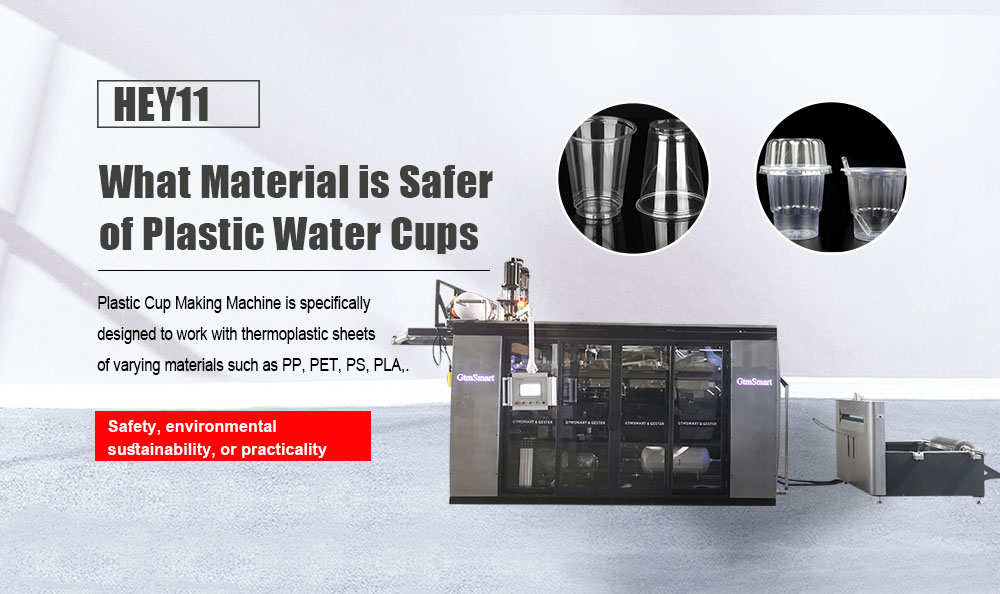What Material is Safer of Plastic Water Cups
In today’s fast-paced world, the convenience of plastic water cups is well-received. Yet, amidst this convenience lies a labyrinth of questions about their safety, particularly concerning the materials they’re made of. This article aims to dissect and compare various food-grade plastic materials commonly used in water cup production, shedding light on their safety profiles and implications for human health.
Introduction
Plastic water cups have seamlessly integrated into our daily lives, serving as indispensable vessels for hydration. However, as consumers become increasingly conscious of health and environmental issues, the safety of these cups is under scrutiny. Understanding the nuances of different plastic materials used in cup production is crucial for making informed choices that prioritize both health and sustainability.
Polyethylene Terephthalate (PET)
Polyethylene terephthalate (PET) is a widely used plastic known for its clarity, lightweight, and recyclability. PET water cups are favored for their convenience and affordability, often found in vending machines, convenience stores, and events. While PET is generally considered safe for single-use applications, concerns arise regarding its potential to leach chemicals, especially when exposed to high temperatures or acidic beverages. As such, PET cups are best suited for cold or room-temperature drinks to minimize the risk of chemical migration.
Polypropylene (PP)
Polypropylene (PP) is a versatile plastic valued for its heat resistance, durability, and food-grade status. PP water cups are commonly used in restaurants, cafes, and households, appreciated for their robustness and suitability for both hot and cold beverages. PP is inherently stable and does not leach harmful chemicals under normal conditions, making it a preferred choice for food and beverage containers.
Polystyrene (PS)
Polystyrene (PS) cups, often recognized as Styrofoam, present several advantages in specific usage scenarios. Their lightweight nature makes them ideal for events, picnics, and outdoor gatherings, where portability is essential. Additionally, PS cups boast excellent insulating properties, keeping beverages at desired temperatures for extended periods. This feature makes them a preferred choice for serving hot drinks like coffee and tea, ensuring that beverages remain warm and enjoyable. Moreover, PS cups are cost-effective, making them a practical option for large-scale events or businesses seeking economical solutions without compromising quality.
Comparative Analysis of Food-Grade plastic cups
When it comes to selecting food-grade materials for water cups, a comparative analysis can help elucidate the strengths and weaknesses of each option.
1. Safety and Stability:
- Polyethylene Terephthalate (PET): PET cups offer a balance of safety and convenience. They are widely accepted as safe for single-use applications and are suitable for cold beverages. However, caution is advised when using PET cups with hot liquids or acidic drinks due to the potential for chemical leaching.
- Polypropylene (PP): PP cups are renowned for their stability and resistance to chemical leaching, making them a preferred choice for food and beverage containers. They are versatile, durable, and suitable for both hot and cold beverages, making them a versatile option for various settings.
- Polystyrene (PS): PS cups offer lightweight convenience and excellent thermal insulation. PS cups remain popular for specific applications where cost-effectiveness and insulation properties outweigh long-term health considerations.
2. Environmental Impact:
- Polyethylene Terephthalate (PET): PET cups are widely recyclable, contributing to reduced environmental impact when disposed of correctly. However, their single-use nature and limited recyclability pose challenges in addressing plastic pollution.
- Polypropylene (PP): PP cups are recyclable and can be repurposed into various products, reducing their environmental footprint. Their durability and potential for reuse make them a more sustainable choice compared to single-use alternatives.
- Polystyrene (PS): PS cups, while lightweight and cost-effective, pose challenges in terms of recycling and environmental impact. Their low recyclability and persistence in the environment underscore the need for alternatives that prioritize sustainability.
3. Versatility and Practicality:
- Polyethylene Terephthalate (PET): PET cups offer convenience and affordability, making them suitable for events, parties, and on-the-go use.
- Polypropylene (PP): PP cups stand out for their versatility, stability, and suitability for various beverages, including hot drinks. Their robustness and resistance to chemical leaching make them a practical choice for everyday use in homes, restaurants, and cafes.
- Polystyrene (PS): PS cups excel in situations where lightweight portability and thermal insulation are essential, such as outdoor events or fast-food establishments. However, their limited suitability for recycling and potential health concerns necessitate careful consideration of alternative options.
The choice of food-grade materials for water cups involves weighing various factors, including safety, environmental impact, versatility, and practicality. While each option offers distinct advantages, consumers must prioritize their preferences and values to make informed decisions that align with their health and sustainability goals.
Related Plastic cup making machine
GtmSmart Cup Making Machine is specifically designed to work with thermoplastic sheets of varying materials such as PP, PET, PS, PLA, and others, ensuring that you have the flexibility to meet your specific production needs. With our machine, you can create high-quality plastic containers that are not only aesthetically pleasing but also environmentally friendly.
Conclusion
Whether prioritizing safety, environmental sustainability, or practicality, consumers can make informed decisions by weighing the advantages and disadvantages of each material. Furthermore, advancements in technology and manufacturing processes continue to drive innovation in the production of plastic cups, offering opportunities to address safety and environmental concerns. By staying informed and considering the broader implications of their choices, consumers can contribute to a safer and more sustainable future for plastic water cup consumption.
Post time: Feb-28-2024

